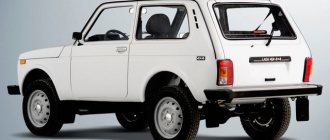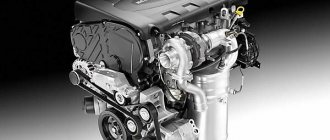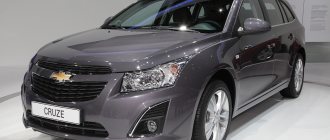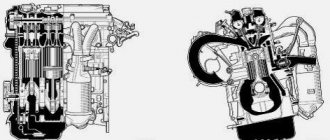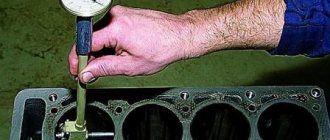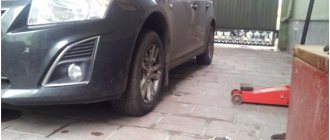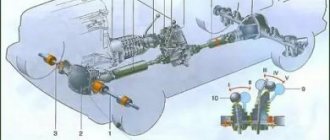Niva-chevrolet diesel
Further attempts to almost “officially” install a diesel engine on the Niva (Niva-Chevrolet model) were made in the city of Togliatti. For this, a tuning studio called “Tema-Plus” received permission from the manufacturer GM-AvtoVAZ. The main modification of the Niva-Chevrolet model was the installation of an Italian diesel engine produced by Fiat paired with a Japanese Aisin transmission.
| Working volume: | 1929 cm3 |
| Power: | 90 hp |
| Maximum torque: | 195 Nm |
| Average fuel consumption per 100 km: | 7.5 l |
The installation of a diesel engine and an improved transmission made it possible to provide the Niva-Chevrolet 1.9 TD tuning model with high torque in the low speed range, as well as acceptable acceleration dynamics. Such a car cannot be considered serial, but this version of the Niva-Chevrolet diesel engine is noticeably closer in level to the factory assembly. The only negative is the greatly increased final price of the SUV modernized by the tuners.
"Chevrolet Niva"
Intelligent tuning and modernization are, albeit distant, but relatives, and sometimes the first one turns out to be wealthier than the second. It is more flexible and efficient, since it is not constrained by production boundaries, and therefore many automotive giants keep their tuning studios at their court.
Tolyatti “Transmission Systems” are also, apparently, candidates for the court: they have improved the consumer properties of the Chevrolet Niva at little cost. The engine was subjected to tuning, the character of which was noticeably changed, making it more flexible, and the corrective work cost the buyer only 13,500 rubles.
To begin with, we worked on the block head. The cross-section of the intake and exhaust channels was increased by 15%, the valves and seats were modified, the intake system was optimized and a dual exhaust pipe was introduced.
I have two cars at my disposal - an improved one and a regular one. For the standard engine, peak torque occurs at 3400 rpm, while for the modified engine it is almost a horizontal “shelf” in the range of 1500–3500.
Limited edition
In addition to the main versions, the Chevrolet Niva was produced in a limited version with an Opel engine and a Suzuki Grand Vitara manual transmission. The engine had a volume of 1.8 liters and was powerful enough for a car with a low weight.
There is a modified version of the Chevrolet Niva Trophy. Equipped with a winch, self-locking differential, snorkel. All these additional mechanisms gave the car additional off-road characteristics.
Hybrid Niva
We began to develop the official version of the Niva for integration into the engine compartment of a diesel engine in a tuning studio in Tolyatti. The legal entity has acquired a recommendation - permission from the plant -. Refinement processes began to adapt the Italian Fiat diesel engine along with the Aisin transmission, produced at one of the Japanese factories.
The competent installation of the Italian diesel engine was a success and showed positive results in test tests:
- The power of the power plant reached 90 horsepower.
- Peak torque stopped at 195 Nm.
- For 100 kilometers the car required only 7.5 liters of diesel fuel.
In practice it turned out better than expected. The combined diesel Italian-Japanese Chevrolet Niva was a great success. In terms of the main technical parameters, the quality is very close to the factory assembly.
One bad news is that the cost of adaptation was high.
Removal and installation of the Niva Chevrolet engine
Removal of the engine on a Niva Chevrolet car is carried out for its repair, as well as when carrying out other work in which its presence will interfere with the progress of their implementation. The engine is removed from the car in an upward direction, so prepare a lift over the hood with a lifting capacity of at least 300 kg. The manufacturer also recommends first disconnecting the gearbox from the power unit and removing the driven clutch disc to prevent damage to it. Prepare a standard set of tools and perform the following sequence of actions:
- Remove the hood.
- De-energize the vehicle by disconnecting the negative terminal from the battery.
- Remove the decorative engine cover.
- Remove the oil pan protection and engine splash guard.
- Drain the cooling system and remove the radiator.
- Unscrew the nuts securing the front engine mounts to the suspension cross member.
- Unscrew the nuts securing the front cover of the clutch housing.
- We unscrew the bolts securing the clutch slave cylinder and, without disconnecting the hose from it, move the cylinder to the side so that it does not interfere with further work.
- Unscrew the four bolts securing the clutch housing to the engine block.
- Then unscrew the nut of the clamp securing the exhaust pipe to the bracket and disconnect the clamp.
- We disconnect the block with the supply wires from the engine knock sensor.
- Disconnect the positive wire from the generator terminal.
- Having removed the wires from the terminal, we move the harness to the side.
- Next, we dismantle the air filter.
- From the intermediate bracket, loosen the clamp, remove the left part of the air supply pipe.
- Using a Phillips screwdriver, loosen the clamp securing the right part of the air supply pipe to the throttle assembly, then unscrew the bolt securing the intermediate bracket and move the right part of the pipe to the side without disconnecting the crankcase ventilation hose.
- From the throttle position sensor and idle speed control, disconnect the connectors with the power wires.
- Next, disconnect the wires from the fuel injectors and coolant temperature sensor.
- We remove the engine wiring harness from the holder brackets and move it to the side.
- Disconnect the block with wires from the ignition module.
- Unscrew the nuts and disconnect the ground wires from the ignition module terminals.
- Disconnect the wire from the emergency oil pressure drop sensor in the system.
- Similarly, disconnect the wire from the fluid temperature indicator sensor.
- Remove the belt from the hydraulic power steering pump pulley.
- Disconnect the block with power wires from the crankshaft position sensor.
- Unscrew the bolts securing the hydraulic power steering pump bracket and move the bracket with the pump to the side, fixing it on the body so that it does not interfere.
- We unscrew the mounting bolt and disconnect the ground wire from the engine, removing it together with the bracket.
- We disconnect the throttle cable from the throttle assembly drive sector. We also disconnect it from the bracket on the receiver.
- From the intake pipe, loosen the clamp and remove the vacuum brake booster hose.
- Having loosened the clamps, disconnect the upper and lower radiator hoses from the thermostat pipes.
- Disconnect the adsorber purge hose from the throttle body pipe.
- Next, loosen the clamp securing the hose to the expansion tank.
- Disconnect the hose from the tank and fix it to the engine.
- We disconnect the fuel supply and drain lines.
- Disconnect the hoses from the heater radiator pipes.
- Remove the generator.
- We unscrew the bolt of the lower fastening of the intake pipe spacer and move it away so that it does not interfere with removing the starter.
- Remove the starter.
- We unscrew the nuts securing the exhaust pipe to the exhaust manifold and, having removed the nuts from the studs, move the pipe away from the engine.
- Unscrew the bolt securing the rear exhaust pipe strut and remove it.
- Now you need to secure one of the slings to lift the engine. It is more convenient to attach the sling to one of the transport eyes installed on the upper bolts of the clutch housing. We remove the eye from the bolt and fasten it in place of the engine ground wire.
- We fasten the lift slings to the standard and newly installed slings.
- Unscrew the bolts and remove the reinforcement of the front panel of the engine compartment frame.
- We install a wooden block, 60-70 mm thick, between the clutch housing and the anti-roll bar bar and lower the engine a little so that the block is clamped, after which we move the engine a little forward.
- After the input shaft has completely exited the driven disk hub, lift the engine and remove it from the engine compartment.
At this point, the repair work to remove the engine on the Niva Chevrolet has been completed. Carry out the necessary repairs, then install it in the reverse order.
Sources:
https://www.chevyman.ru/Niva/1/power/engine/snyatie-i-ustanovka-dvigatelya https://sinref.ru/avtomobili/GAZ/012_Shevrole_Niva_rukovodstvo_po_remontu_doc/004.htm https://avtomechanic.ru/ niva-chevrolet/dvigatel/snyatie-i-ustanovka-dvigatelya-avtomobilya-niva-shevrole https://autoruk.ru/marka-avto1/niva-chevrolet/dvigatel/kak-zamenit-dvigatel-vaz-2123 https:// remladavaz.ru/snyatie-i-ustanovka-dvigatelya-niva-shevrole
Engine advantages
The engine with 16 valves turned out to be very successful. Many owners install it not only on VAZ “classics”, but also on new models (“Niva-Chevrolet”, 2109, 2114). On such cars, installation of the power unit is greatly facilitated due to the combination and identity of most of the elements.
The VAZ-2107 with an engine from Priora has the following advantages:
- high engine performance in terms of torque, power and fuel consumption;
- the product is created using modern technologies;
- the versatility of many elements and components, compatible with other VAZ engines, allows you to install the unit on different car models;
- the design of the power unit from Priora does not imply constant adjustment of valves and tightening of the timing chain;
- The motor is considered one of the best among domestic units.
A Chevrolet Niva with an engine from a Priora, the price of which depends mainly on the general condition, turns out to be more economical without losing maneuverability and power. The unit will cost from 35 to 100 thousand rubles.
Also interesting: Weak points and malfunctions of the Chevrolet Niva
Engine of the restyled Chevrolet Niva
Since the disappearance of the FAM-1 engine, many design changes have been made to the Chevrolet Niva car. The characteristics of the engine and its main indicators remained almost the same, but many parts were modified and became much better in operation and more wear-resistant.
Thus, modern engines have the following advantages:
- the pistons have been improved due to the reinforcement of the skirt;
- connecting rods have become lighter;
- the tensioner drive has become hydraulic;
- the double-row chain was replaced with a new one - quieter and lighter;
- the fuel filter changed its location and was moved to the underbody;
- the motor received a new control system - a special electronic unit, thanks to which starting has become easier;
- traction has been improved, making it possible to change gearbox speed less often;
- The Chevrolet Niva engine has a dual lubrication system - under pressure and by splashing;
- the neutralizer received an additional muffler;
- injectors and an ignition coil of our own production appeared, fully adapted to the car;
- toxicity level meets Euro-5 standards;
- the jets limit the volume of sucked gases, thus at idle speed the operation of the engine is not disrupted;
- on the Chevrolet Niva, engine cooling has become better due to increased airflow.
Air intake
Modern engines on the Chevrolet Niva are equipped with a new air intake system, which is characterized by an increased volume of the air filter. Design changes also affected such details as:
- Inlet pipe with pipes;
- Receiver;
- The throttle type has replaced it.
The entire electronic system works thanks to a controller which can be the following:
Thanks to the improved injection control system, which has a pair-parallel design, it becomes possible to control fuel consumption. The injectors in the fuel rail are installed "SIEMENS" type. In order to protect the engine, a special plastic casing is installed.
History of diesel engines in the field
The desire to improve fuel efficiency and add strength to the model was undertaken more than once by the manufacturer itself. Thus, in 2021, the engine from Fiat cars under the general name MultiJet was actively tested on the VAZ-2121. This power unit received the title “Engine of the Year” back in 2005, and it was actively installed on the Fiat Doblo.
It is difficult to call the technical characteristics of the motor outstanding from the perspective of today:
- Working volume – 1.3 l.
- Torque – 180 Nm.
- Installed power – 85 hp.
When testing the engine, it turned out that modernization of transmission elements is required, since a unit with a torque of up to 165 Nm can be installed on the Niva. Given the crisis in the country at that time, a good idea was postponed for an unknown period of time.
Another indirect example of attempts to introduce a diesel heart was the release of a trial batch of Chevrolet Niva to the market. The Togliatti company began installing diesel engines. They even managed to get permission to keep the trademark.
The Chevrolet Niva model received a set of two diesel engines - a naturally-aspirated diesel engine and an engine with a turbo prefix. The machine had the following technical characteristics:
- Working volume – 1.9 l.
- Torque – 195 Nm.
- The installed power of the naturally aspirated engine and turbo is 100/120 hp. With. respectively.
- Fuel consumption is about 7.5 l/100 km in mixed driving mode.
With such equipment, the Chevrolet Niva lost in dynamics, and the workmanship did not satisfy customers. Perhaps for this reason, such a machine was not widely used.
Methods to increase the output of a Chevrolet Niva engine
Tuning the Chevrolet Niva engine can be done using one of the methods described below. The car owner can optimize the car by:
- replacing standard engine components with more modern tuning elements (changing the geometry of the components);
- turbocharging installations;
- reflashing the electronic control unit (engine chip tuning, which is gaining popularity among all car owners).
In fact, tuning a Chevrolet Niva engine with your own hands is not so difficult, however, along with technical knowledge, the vehicle owner will need considerable financial investments, since without them it will not be possible to optimize the engine, making it as “alive” and dynamic as possible.
Replacing power unit components
Refinement of the Chevrolet Niva engine can begin with the replacement of some components. If a car enthusiast decides to resort to this particular method of modernization, then he will have to pay attention to the cylinder-piston group (CPG) and the crank mechanism (CPM). In addition to all of the above, it will be necessary to bore the sleeves. Thanks to such manipulations, you can try to maximize the working volume and recoil properties.
The motor should be upgraded by means of boring, which helps to significantly expand the internal diameter of the liners. The next step should be a selection of pistons and special ring-shaped elements that will have a certain size. The power unit is then equipped with a crankshaft with enlarged shoulders and smaller connecting rods. The above procedure helps to increase the piston stroke and maximize the volume of the unit, which changes the standard 1.7 to 1.9 liters.
If the tuning of a Chevy engine includes a crankshaft and a cylinder head, then the owner will urgently need to carry out manipulations to increase the volume of the working mixture going to the cylinders, as well as improve their ventilation. Optimization of the engine should also be carried out by modernizing the cylinder head (cylinder head). You will have to bore the intake and exhaust ports, replace the valve (it is necessary to install a standard element of a larger diameter), bore or change all the valve seats.
Complete modification of a Chevrolet engine with your own hands should include a procedure for replacing the exhaust system of the unit. The fact is that by trying to maximize the size of all exhaust pipes, it will be possible in addition to changing the factory catalytic converter, instead of which a flame arrester will be installed.
Tuning the Niva engine, which involves an important structural restructuring of the entire unit, entails the need to change the fuel supply system. While maintaining the factory configurations, even significantly increasing the volume, the motorist will not be able to notice the changes that have occurred due to the fact that the fuel that will enter the cylinders will not be enough. In other words, constructive reconfiguration of the system requires mandatory chip tuning.
As a rule, the changed geometry of the power unit is directly related to its performance, due to which the motor will have 15% greater output than before the optimization procedure. True, the modernized engine will begin to “demand” more power from the owner (the amount of fuel consumed will increase).
Installation of turbocharging on a Chevy Niva car
The second method by which the Chevrolet Niva engine will be modified is the installation of turbocharging. This method is considered one of the most effective, as it allows you to increase productivity and at the same time “raise” torque levels.
With the help of turbocharging, you can achieve a high level of filling the cylinders of the power unit with air due to the fact that forced injection will be present. If a motorist decides to modify the engine in this way, he will definitely have to buy a high-quality turbine, otherwise the positive effect will not be as good as it should be.
On auto forums you can find reviews from Chevy Niva owners who, thanks to tuning, increased engine output by 30%. It is worth noting that installing turbocharging helps not only increase power, but also reduce the amount of fuel consumed. This is due to the fact that maximized output is ensured by better combustion of the fuel mixture and ventilation of the engine cylinders.
Reprogramming the electronic control unit
Chevy engine chip tuning can be considered the most popular method of vehicle modernization. Despite the fact that upgrading in this way does not require too much cost and is considered a relatively budget option for optimizing the capabilities of the engine, the method can be considered quite effective. It is worth considering that do-it-yourself chip tuning does not affect the technical part of the power unit, subjecting it to design alterations.
Chip tuning of a Chevrolet Niva involves making adjustments to the software of the standard ECU, adjusting the fuel supply complex.
Tuning a Chevrolet engine through chipping is good because the motorist can reprogram the ECU at his own discretion. For example, by changing the software, you can reduce fuel consumption, which will occur due to a change in the dynamic and power properties of the engine. As a counterbalance to this, the performance of the power unit can be increased, which, naturally, will increase the volume of fuel required. In addition to all of the above, you can install software that will optimally modernize the operating properties of the engine and maintain gasoline consumption at an acceptable level.
Niva Chevrolet 1.9 diesel
The Chevrolet Niva diesel floor has a heating function to make the ride for passengers in the back row more comfortable. Do you seriously believe this? If you are determined to install such a motor, experts recommend using power units from Peugeot, Toyota, Renault, Fiat and Volkswagen.
Niva Chevrolet with a diesel engine. A diesel engine is a suitable purchase for any car. Diesel engine installed
Self-installation of a diesel engine.
The second nuance is the increase in load on the front axle after installing a diesel internal combustion engine on the Niva, since an engine of this type is often heavier. Let's take a closer look at the main features of the Chevrolet Niva diesel.
Service
To achieve maximum service life, it is important to properly maintain the motor. First of all, it is worth remembering the importance of timely replacement of engine oil. It is recommended to carry out this work once every 15 thousand kilometers. Every second replacement should be combined with washing. This recommendation applies to both engines.
It is also worth choosing the right oil. The Z18XE engine should only be filled with synthetics; the best options would be:
- 0W-30;
- 0W-40;
- 5W-30;
- 5W-40;
- 5W-50;
- 10W-40;
- 15W-40.
It will require approximately 4.5 liters.
The VAZ-2123 engine is filled with 3.75 liters of lubricant; here it would also be optimal to use synthetics. For other parameters, you can use the same oil as for the engine described above.
The VAZ-2123 engine has a timing chain drive. In this regard, it is changed quite rarely. The average service life between replacements is 150 thousand kilometers. At the same time, the manufacturer does not regulate the time of replacement. Everything is determined by the signs of a problem, first of all we are talking about increased engine noise, especially when picking up or dropping speed.
The Z18XE motor is belt driven. According to the manufacturer's specifications, it must be replaced at 60 thousand kilometers. And according to the experience of car enthusiasts, it is better to do this after 45-50 thousand, as there is a risk of breakage. In this case, you will get bent valves.
Third step: flashing the ECU
The most inexpensive way to increase the power of an off-road SUV, because chip tuning is a software modification and does not involve technical intervention.
Replacing and adjusting ECU software is the essence of flashing. In this way, it is possible to change the operation of the electronic control unit, adjust the fuel supply and reduce its consumption, due to the engine’s performance in terms of power and dynamics. You can increase engine power by about 15% just by chipping.
Peculiarities
The Niva-Chevrolet with the Priora engine has some features compared to similar classic VAZ models. Firstly, installation of the power unit is simplified, since the location of the motor is identical. Secondly, variations were produced with almost the same engine as the Priora. In addition, a new production version of the domestic SUV is being developed, to which the engine from Priora, considered one of the best among our manufacturers, is adapted.
Also interesting: Removing the Niva engine. Video on how to remove the engine from a Niva yourself in your garage
Considering the high service life and versatility of the motor in question, its installation is advisable on many VAZ models. Moreover, relatively modern modifications will require a minimum of modifications, while more classic versions will gain new power and speed.
Chevrolet Niva L-Tank2016 › Logbook › Shnivy engine tuning, OKB Engine. Part 1.
“Horsepower sells cars, torque wins races.” — Enzo Anselmo Ferrari is an Italian designer and racing driver, founder of the automobile industry. There is a version that this phrase belongs to Henry Ford, but I don’t care. This phrase fully reflects what is happening now in the auto industry, people are sold cars with powerful engines, although this may not be reflected in the dynamics of acceleration and its traction characteristics from idle to the maximum speed that you use. Can a 1.6-liter engine with a power of 120-130 hp be considered “comfortable”? if this power is delivered at 7000 rpm in civilian use around the city? I'm sure not. When applying it to my car in the city, I use a range from 1000 to 3000 rpm, when driving on the highway the main speed is from 2500 to 4500 rpm, very rarely I turn it higher and only because I need to overtake some car, otherwise some heavy truck will smear you on the asphalt. The maximum engine power primarily determines the maximum speed of the car. And torque is how quickly the motor reaches this maximum power. So, look at the manual for the Chevrolet Niva engine parameters: engine power 80 hp at 5000 rpm, torque 127.4 N*m at 4000 rpm. It turns out that 80 hp. On the Shnivy it gives us a declared maximum speed of 140 km/h, and 127 N*m - 19 seconds to 100 km/h. A torque of 127 N*m for a 1.7-liter engine is an outright disgrace to our automobile industry, and what can you expect from a block and head that has not fundamentally changed since the early 70s of the last century. Soon we will be able to celebrate (think about it) our fiftieth anniversary! of this engine. What do I want from a newly purchased car? Of course, dynamics, faster acceleration to 100 km/h, good traction from idle and up to 4500 - 5000 rpm with a reserve for overtaking. I began to deal with this issue immediately after purchasing the car in November 2021 and looked and talked with all the available camshaft manufacturers at that time. Reviews about companies producing camshafts are very contradictory. I also talked and corresponded with Anatoly Pavlovich Rozhkov, chief designer and owner of the OKB Dvigatel company, he used to work at the Dynamics Design Bureau, an old man, but is in perfect health and continues his work to this day, not every young person can follow him keep up. He also gave me Igor’s contacts; he is known on the drive by his underground pseudonym mehanis. Together they design and develop the intake and exhaust for each shaft, mainly for cars of our domestic automobile industry, but there is work on foreign engines. In a long correspondence with Igor, I realized that I would order everything in a complex: a camshaft for hydraulic compensators 21214-1006010-04+4 (6800 rubles), ECU firmware (5000 rubles) for this shaft - which Igor wrote himself and has already tested on many Shnivas from the European part of Russia there are real reviews about this, and the receiver is the intake manifold (7000 rubles). Frankly, even at the beginning of summer, on vacation, I wanted to go to Ufa on my own and install everything there, but I calculated the costs and realized that traveling 2000 km one way is expensive! As a result, looking ahead, I found a very competent person in Novosibirsk and will do mechanical work here. For the experiment to be a success, ideally it was necessary to find a dyno stand and, step by step, install the tuning components on the car, take measurements and measure torque and power each time, install the ECU - measure, install the camshaft - measure, install the receiver - measure. But to my shame, I never found a dyno in such a big city as Novosibirsk. There is a stand at the Engineering Institute of NSAU, but it only measures up to 3000 rpm, with the engine removed from the car, TsARZ - 15 in Akademgorodok is the same parsley, someone said that there is a wheel stand at the Railway Institute, but I never found any contacts. I will take measurements using the program on my smartphone Speed Logic Lite, the best free one I found on the Play Market. We will measure the dynamics of acceleration in seconds from 0 to 80 km/h, from 0 to 100 km/h and the time it takes to pass a quarter of 402 meters.
Features of installation of the power unit
Installing a Priora engine on a Niva-Chevrolet or VAZ 2107 will take one or two days from a specialist. But first you should devote a lot of time and money to preparatory work. First you need to buy the engine itself. If you purchased a used motor, you need to rebuild it, which will further extend its service life.
Another advantage of disassembling and inspecting the unit is the ease of installation of the transition elements and cylinder block, especially if the parts for the Chevrolet Niva with the Priora engine were made by hand. It is better to carry out manipulations with a screwed oil pan, which will also require modification.
"Niva-Chevrolet" with an engine from "Priora": the main stage of preparatory work
The updated engine will be slightly moved towards the cabin. To install it correctly, it is necessary to cut out a part of the metal partition separating the engine unit and the interior of the car. It is recommended to carry out the manipulation carefully so as not to cut out the excess part, since the element being processed ensures the rigidity of the body. Alternatively, you can use a grinder saw if you have the appropriate experience.
A support bearing will need to be installed at the end of the crankshaft of the newly installed motor. VAZ-2107 and 21213 Niva with an engine from Priora require element adjustment. Any turner will help you cope with this problem; the work will not take much time. Adapters with holes should be prepared for the motor mounting pads.
Attempts by the plant to install diesel
The manufacturing plant made attempts to install a diesel power plant on the Niva-2121 car. It was planned to use a 1.5-liter turbocharged engine. Cars equipped with such engines that underwent testing turned out to be low-power. But attempts to equip all-wheel drive with a promising internal combustion engine continued. The Chevrolet Niva diesel car, which turned out to be unpromising, was equipped with a large-volume engine.
Soon the factory workers abandoned attempts to equip the SUV with a diesel power unit. The model remained out of series.
Removal and installation of the Niva Chevrolet engine
The engine is removed from the car upwards. To remove the engine, a lifting device with a lifting capacity of at least 300 kg is required.
The car must be installed on a lift, inspection ditch or overpass.
Before removing the engine, it is necessary to prepare a reliable stand on which the engine must stand steadily.
It is easier to remove the engine if you remove the hood.
Before disconnecting hoses and electrical wires, we recommend that you mark them so as not to mix them up during assembly.
The manufacturer recommends removing the engine by first disconnecting the components of the power unit: the gearbox with the clutch housing remains on the car, and when removing the engine, the front bearing of the gearbox input shaft and the clutch driven disc hub are removed from the input shaft.
You will need: keys “10”, “13”, “17” and “19” (or a head with extensions and a universal joint), screwdrivers (two), a mandrel for centering the clutch driven disc, pliers, a hoist or other lifting device, slings (strong rope).
1. Remove the hood.
2. Disconnect the wires from the battery.
3. Remove the decorative engine cover.
4. Remove the oil sump protection and engine splash guard.
5. Drain the liquid from the engine cooling system (see “Replacing the Niva Chevrolet coolant”).
6. Remove the cooling system radiator.
7. Unscrew the nuts securing the front engine mounts to the front suspension cross member brackets and remove the washers installed under them.
8. Remove the bolts securing the front clutch housing cover.
Problem
The question, as always, turned out to be extremely simple - the quality of the original delivery. It turned out that the Chevrolet Niva heater motor was supplied to the conveyor assembly assembled from the Kaluga plant. The official name of PJSC Kaluga Automotive Electrical Equipment Plant is KZAE. This plant, as you know, is almost entirely configured to work with the Volkswagen plant, which is located there, and supplies products to AvtoVAZ only for the assembly line.
And even these supplies are not enough and we have to install stove motors from other manufacturers. There is a very big difference, both in the resource of spare parts and in the ease of installation. Of course, the main supplier of the Russian spare parts market is China or Luzar (which is not very important). The motors initially hum very loudly, but most importantly the impeller is pressed onto the motor shaft.
While on the Kaluga product it is located on a lock washer, which greatly facilitates the installation and dismantling of the spare part. There is another Tolyatti product, if I’m not mistaken, of a similar design. But with a minimal difference in price, it is better to supply a conveyor original, especially since, as I said earlier, the plant serves Volkswagen.
Calculation for foreign internal combustion engines
Car production engineers did not abandon the idea of adding a foreign diesel engine to the Niva. The choice fell on the French Peugeot xud9sd with a power of about 80 horsepower. The choice of Russian specialists was motivated by the simple design of the diesel engine. Foreign engines have longitudinal cylinder placement. There are 4 of them, with a working volume of 1905 cubic centimeters.
During testing, the installed engine showed the following characteristics:
- power at peak torque was 70 horsepower at a crankshaft speed of 4600;
- the car reached a cruising speed of 120 kilometers per hour;
- Fuel consumption when driving a car for 100 kilometers was 8.7 liters.
Experimenters who installed a foreign diesel engine in the field obtained excellent results:
- The Russian Niva Chevrolet diesel turned out to be not only an economical model, but also showed excellent off-road performance;
- Moreover, at low speeds it demonstrated powerful torque, which is important for driving on country dirt roads;
- The positive results were complemented by simple repairs and maintenance of motors.
During the testing process, negative aspects also emerged:
- The slowness of acceleration in dynamics at 10 meters was revealed;
- The installation of an imported diesel engine into the Niva confirmed fears that the car would accelerate slowly from the start. On the autobahn this is a significant mode for the driver, but not significant when driving on total off-road conditions.
Based on the results obtained, it was decided to put the car into mass production. But they came off the assembly line in limited quantities. It was never sold in Russia, since the entire series was sent for export. 9 years ago, the assembly line of the Niva 2121 car with a diesel engine stopped.
CHARACTERISTICS OF STANDARD AND MODIFIED ENGINES
First of all, let's refresh the feeling of the standard. The engine is lively in the range of 3000–4000, it also moves from below, but not very willingly, and in higher gears it is capable of pulling from one and a half thousand, although it mutters displeasedly. The finished one works softer. But the main thing is that it pulls almost a thousand, giving the car noticeable acceleration! In the range of 1500–2500, even in fourth and fifth gears, the Chevrolet Niva readily picks up speed. With this engine, she crawls off-road and climbs steep hills more confidently. The serial engine in such inconvenient modes creates the feeling that the gas drive is made of rubber. While it picks up the slack, opens the throttle slightly and the engine finally starts spinning - it seems like an eternity!
Read more: Ural transfer case
Having equipped the cars with measuring equipment, we repeat the races. The results obtained in third and fourth gears clearly show that acceleration at the top is the same for both engines. And the elasticity of the modified engine in top gear has improved: when accelerating from 2500 rpm - by 6%, and from 1800 - by as much as 15%.
Interestingly, reducing the hydraulic resistance of the intake tract usually leads to an increase in engine power and almost does not change the torque. This is where the moment arose. It seems that in addition to (or instead of?) modifications to the intake manifold, the valve timing was also changed, replacing the standard one with a “humpbacked” low-level camshaft, but the company is keeping its secrets. Well, you have to take my word for it. One way or another, driving a car with a modified engine is much more pleasant, and our measurements fully confirm this.
Added bonus: The cabin is a little quieter because upshifts occur earlier. And, what’s especially nice, fuel consumption in the city has decreased by almost half a liter.
Guys, tell me what can be put in the shniva? Preferably a Japanese engine with a power of 150-200 horsepower, no more. Preferably not bulky, so as to minimize cutting of the body. And ideally in a place with a 4 wd gearbox. I would like to get rid of not only the engine but also the gearbox and transfer case.
Swap
One of the popular types of tuning is SWAP. In this case, the motor with poor performance is simply replaced with another, more suitable one. There are many options for such modification. First of all, you should decide what you need and what engine is standard. If you have a VAZ engine installed, you can try installing a Z18XE, in this case you will get an increase of almost 40 hp. and you won't have to redo anything at all. Well, if only the gearbox is changed.
Also interesting: To wash or not to wash the engine? » Lada 4×4 Urban – New Niva Urban 2020
Also, quite often, drivers install the VAZ 21126, which is standardly intended for the Priora. As a result, you will get a longer resource, as well as slightly increased power. To install, you will need to modify the exhaust manifold; it is placed on a thick gasket of 2-3 cm, then the pants will not come into contact with the spar.
Few people know that it was planned to release a diesel version of the Chevrolet Niva. It was supposed to use an engine manufactured by Peugeot - XUD 9 SD. It is almost ideal for Shniva. To install it, no modifications are required at all, only flashing the ECU, after all, the engine is diesel.
For cars with Z18XE, the same recommendations are suitable as for the VAZ unit. The only caveat is turbocharging. The fact is that this engine was originally intended and used for Opel. For German cars there was an option with a turbine. So you can install it, increasing engine power and throttle response. No modifications other than additional tuning of the ECU will be required.
Tags: swap shniva
Comments 92
bring it in, we'll supply you with an engine and gearbox, budget 200,000.00
Our rulers are going to tighten the technical inspection; there is a possibility that the car, after so much effort, will turn into a monument.
Well, it’s unlikely for a monument, but for eternal property, yes.
No inspection, no insurance. No insurance, cameras will automatically issue fines, too expensive to drive
Well, you can always legitimize it, at worst).
No inspection, no insurance. No insurance, cameras will automatically issue fines, too expensive to drive
Do not start. Everyone KNOWS HOW the maintenance is done
If you install the rk from the Isuzu it will be like on a UAZ the butt is completely lowered
Look at 5vzfe 190 mares with about 300 torque. Compact, reliable.
He's too big. There’s a VAZ standing there, there’s nowhere to put your hand.
Toyota 3s-fe series, ge. Gearbox with rk monoblock hice, surf 185.
What's the budget? Start with this
What does the budget have to do with it! You need a motor that will fit with the least amount of modifications. And then scratch your turnips and think about money)
Sr20de is inexpensive, Nissan has many options for all-wheel drive transmissions
For a normal engine, you need a normal transmission. And so put 1 nz, 1zz or 3 s, which is already too much.
What are these motors for?
Toyota 1nz is 1.5 - 109hp -144 nm. It is found on almost all small cars and not only, it costs 20-30 rubles with attachment, but it has an electric throttle, an immobilizer (you need to turn it off) 1zz 1.8 - 120-130hp low-end, a long-stroke engine is available on Avensis, Vish, Rav4, many places, price - 40-50 rubles 3s 2.0 - 140 hp old indestructible engine, I won’t tell you the price. I just figured out that 1 nz at 144nm, versus VAZ’s 127 nm, and 28 horses are not superfluous. The original transmission must withstand all this.
look towards Daihatsu Rocky, there is both part-time and full-time, something very similar in size, maybe it will be normal
It’s much more correct to start the topic with: I have 100 hp, I want to swap a motor for a couple of thousand hp, what do you suggest? And it’s unclear, no budget, nothing
There is a Shniva swap for 5 VZ automatic transmission transfer case multimod. Drives great.
Everything would be very good, the engine is cool, the gearboxes are proven to be unkillable, but damn one thing, but still a Niva, and with an automatic transmission, ah ah ah))! But by the way, the pulley, since such a song is quite suitable for such a Swap! Now, if this same option were for a short one, then it would no longer be interesting, although the v6 fits quite adequately into the classic Niva!
3s-ge beams with its native 6th mortar, and then you will get 210 horses, the gear ratio up to the 6th gear is almost the same as that of the Niva, but I personally will leave the original transfer case (silenced), its strength is enough to turn this nice 4x cylinder motor! Jz, the engine is good, but it will require a more serious redesign of the body! You can have 5vz-fe, v6, a working option, but for me it’s too much for a field!
2jz 4wd see with automatic transmission assembly. or 3sge alteza, the engine actually runs in redline
Jizet is too long)
Normal! Everything fits
2jz 4wd see with automatic transmission assembly. or 3sge alteza, the engine actually runs in redline
What is the length of the 2jz motor? Before giving advice, you need to read what TS writes
Listen, everything will fit, what's your problem? What you think won’t fit? This is purely your problem
I have no problems, but you seem to have a problem with the perception of objective reality. If you are ready to defend your rightness, then I will repeat the question: - What is the length of 2jz? What are the dimensions of the Chevy Niva engine compartment to the radiator, naturally? And don’t write that everything will fit, and if it doesn’t fit, then it’s your problem.))
Read more: How to charge a completely dead car battery
Why should I write this? Are you going to match the sizes?
How narrow-minded do you have to be to offer 2Js to the field? You're already tired of your Jays! Yes, a good motor, but it has its place!
Well 3uz. Listen. If you can’t put it in the field, that’s your problem.
Why is there something I can’t do here? Niva with dvajay will turn into a clumsy cow! Have you heard about weight distribution?
It depends on who does it and how they do it. This job is just too much for your studio to handle.
Jizet of the brain...
Look at another car, the cost of both the work and the engine will surprise you.
An engine and transmission swap is not practical. It makes more sense to buy some kind of Vitara.
Why is it not advisable?
Because for the cost of shnivy and money for a swap, you can buy a ready-made car without a collective farm or a farm. Which will carry the owner’s butt happily ever after =)
The trick is that the entire Niva suspension can be capitalized within 10 thousand rubles. And in general, everything on it will cost several times cheaper than, for example, on a Grand Vitara.
That is, we can’t throw in 20k versus 10k once every 50 thousand kilometers, but we can give a quarter of a lamb for a swap? Well, what kind of nonsense?)
I do everything myself, the swap will cost me along with the engine, maximum 150 rubles.
Well, what's the point? You can throw in 150k, but not 20k for the suspension? This is pure absurdity!
That is, we can’t throw in 20k versus 10k once every 50 thousand kilometers, but we can give a quarter of a lamb for a swap? Well, what kind of nonsense?)
This is not nonsense, this is interest!
Because for the cost of shnivy and money for a swap, you can buy a ready-made car without a collective farm or a farm. Which will carry the owner’s butt happily ever after =)
In my case, for example, and as I understand in this one! Buying Vital will not satisfy the needs, but a lying Niva is already much nicer than some kind of Vitara)))))
Because for the cost of shnivy and money for a swap, you can buy a ready-made car without a collective farm or a farm. Which will carry the owner’s butt happily ever after =)
Any swap is justified if everything is satisfactory except the engine.
Everything is always determined by cost and time. When it’s easier to buy a ready-made car, a swap will always be pointless.
In the case of such a global uprooting of the field, this is the most reckless decision. The author argues in the form of inexpensive maintenance in comparison with ready-made carriers of units for swap. But for some reason no one takes into account time, which is an irreplaceable resource, and the fact that the field remains forever.
Thus, for the sake of imaginary penny savings on maintenance, the author wants to bury a lot of money and time into nowhere.
So what should justify a swap from all of the above?)
The desire to do everything yourself is enough. And it may not be about money at all, although it means a lot.
When a person wants to swap, he knows why he needs it and what he will swap. He takes it and gets married.
When he doesn’t need it, he goes to the forums with the question “what can be swapped?” And then the forum users begin to advise everything. And the answer to this question is simple: you can swap anything and anywhere (within reasonable limits). Therefore, it would be easier and better for this author to sell what he has and buy what he needs more.
But that's my opinion.
I agree with you, you are right
The desire to do everything yourself is enough. And it may not be about money at all, although it means a lot.
Everything is always determined by cost and time. When it’s easier to buy a ready-made car, a swap will always be pointless.
In the case of such a global uprooting of the field, this is the most reckless decision. The author argues in the form of inexpensive maintenance in comparison with ready-made carriers of units for swap. But for some reason no one takes into account time, which is an irreplaceable resource, and the fact that the field remains forever.
Thus, for the sake of imaginary penny savings on maintenance, the author wants to bury a lot of money and time into nowhere.
So what should justify a swap from all of the above?)
I am making a car for myself! Investing 100-150 thousand rubles in a car once is not such a huge amount of money. I financial side is not the main criterion. I live in the province. Let’s say the CV joint on the Vitara has fallen out, by the time I order it, by the time it arrives, roughly speaking, the car will sit for about a week. I am extremely unhappy with this. And so changing the CV joint on the shnivy will take just one day. And in general, all spare parts for it are available.
Technical data
The car is equipped with a 1.7-liter power unit and has a power of 80 horsepower. Corresponds to the fourth environmental class and can be used in many countries around the world.
Absolutely all of these motors undergo factory testing. Such a power plant is capable of accelerating a Chevrolet Niva to 140 kilometers per hour.
Considering that the car is an SUV, fuel consumption is quite low:
- Urban cycle - 14 liters;
- Extra-urban cycle - 8.8 liters;
- Mixed cycle - 10.8 liters.
The engine is very well adapted to 92 octane gasoline. The attachments are mounted directly on the power unit and are driven by a belt drive.
The engine power is quite enough for off-road driving and in the city.
Of course, the vehicle is not designed for rally and city racing. Intensive operation has a negative impact on the engine and transfer case.
The photo shows a Chevrolet Niva with a new Opel engine:
New engine for Chevrolet Niva cars
According to the manufacturer, the Chevrolet Niva is a modern SUV with all-wheel drive, which was in development for a long time, but was nevertheless presented to the Russian consumer.
And very soon a new version of the car is also preparing to enter the world. But, unfortunately, the Togliatti plant cannot always find suitable suppliers of components, which negatively affects the development process and the speed of release of the new model.
Nevertheless, manufacturers often manage to find a worthy alternative; today, the Niva equipment meets Euro-5 standards. In Russia, this car was twice awarded the title “SUV of the Year”.
In 2021, production of new engines was launched.
The motor is suitable for some Lada models, as well as the Chevrolet Niva. The 1.8 liter engine is made on the basis of the old VAZ-21127, with a volume of 1.6 liters.
Significant changes have appeared in the design and characteristics of the new engine:
- the appearance of an additional oil channel between the cylinders;
- a mechanism for changing the gas distribution at the inlet appeared - the mass of parts was reduced, which helps to let in more air and reduce friction between surfaces;
- the bearing housing has been changed, which allows you to add a phase sensor;
- a precise system for installing the timing drive has appeared, making phase adjustment more accurate;
- the piston height has increased, which allows the engine heating temperature to be reduced;
- the upper crankshaft liner has a different groove shape, which helps save lubricant consumption;
- the water pump was replaced with a pump, with its help pumping liquids through the engine will be better;
- The performance of the oil pump was almost doubled, and the diameter of the oil intake pipe was also increased for this purpose.
The Chevrolet Niva, whose new engine will become more powerful and more economical, will be faster and more reliable. The characteristics of the new motor are as follows.
Power – 122 horsepower at 6 thousand rpm.
Torque has increased to 170 Nm and is achieved at 3,700 rpm.
Owner reviews
The best recommendations can be given by the direct owners of the model in question, who have tested the car in various weather and road conditions. If you take a Chevrolet Niva with an engine from a Priora, reviews from owners indicate that the car has changed for the better. Special benefits include the following:
- the power unit has a solid reserve before major overhaul;
- fuel consumption has decreased, quite noticeably;
- high speed characteristics and power;
- reliability of the unit;
- high performance characteristics of the motor.
It’s not difficult to create a Niva-Chevrolet with an engine from a Priora. Some modifications to the cooling system and the seat for the unit will be required. All manipulations can be completed in just a couple of days.
The disadvantages of the device in question include one point that was noticed by some owners and specialists. If the timing belt breaks, the pistons inevitably interact with the valves, causing the latter to bend. To avoid this, you can purchase special pistons with recesses for the valves.
Reviews of Chevrolet Niva engines
There are different points of view regarding which engine in the Chevrolet Niva is good or bad.
According to car owners, the engine is reliable, but rather weak. The car takes a long time to accelerate, but it is quite possible to drive at a speed of one hundred and forty to one hundred and sixty km/h. Drivers report high noise levels.
Many car owners complain about the small engine size. The problem is solvable; with minor repairs, it is possible to increase the piston stroke by two mm, increase engine volume to two liters, and power to one hundred horsepower.
On the positive side, it can be noted that the engine, if properly cared for, does not break down often, and it practically does not rust. In case of repair, the parts are inexpensive and quite available on the market.
After 2014, the Chevrolet Niva, whose engine speed was slightly increased, became more maneuverable. In addition, after a number of changes by the manufacturer in the engine design, car enthusiasts noticed a decrease in noise levels, better performance of the water pump, and a decrease in fuel and lubricant consumption.
In addition, many car owners are interested in replacing the old engine with a new one with a volume of 1.8 liters. The Chevrolet Niva, whose new engine has been tested by the manufacturer, promises to be easier to drive and even more economical.

